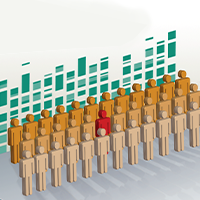Advancing the Development of AAV-Based Gene Therapy for Rare Diseases
Cell Gene Therapy Insights 2018; 4(7), 671-678.
10.18609/cgti.2018.065
Audentes’ lead product candidate AT132 is targeted against X-Linked Myotubular Myopathy (XLMTM) – tell us about the unmet medical need here, and why gene therapy offers new hope to patients?
X-Linked Myotubular Myopathy is caused by mutations in the MTM1 gene that lead to a lack or dysfunction of myotubularin, a protein that is needed for normal development, maturation and function of muscle cells in the body. XLMTM affects boys and is characterized by extreme muscle weakness, respiratory failure and early death, with an estimated 50% mortality by 18 months of age. For those that do survive past infancy, the morbidity is high, due in large part to the respiratory complications associated with the need for significant ventilatory support required by most XLMTM patients. These boys are wheelchair bound for life, need gastric feeding tubes for nutrition and never meet most of their developmental motor milestones.
Management of XLMTM requires a high degree of healthcare services utilisation. This includes the involvement of a range of specialists working to support the child and family, and typically involves multiple, prolonged periods of hospitalisation and surgical interventions, especially in the early months of life.
However, we do believe there is a reason for hope. The genetics and pathology of XLMTM make it a good target for gene therapy. It is a monogenic, recessive disease, meaning that a gene replacement strategy has the potential to address the underlying genetic defect. In other words, we can replace the DNA that codes for myotubularin within the muscle cells themselves. Muscle cells also happen to be a really good target for AAV8, which is the vector capsid we use for AT132, our product candidate for the treatment of XLMTM.
In addition, there is no ongoing inflammatory process or destruction of muscle tissue in XLMTM patients, meaning it is a relatively non-progressive, non-degenerative disease. This provides us with the opportunity to restore meaningful neuromuscular and respiratory function across the affected age range of the prevalent patient population.
What challenges have you encountered in clinical trial design and patient recruitment for this particular indication, and how have you sought to address them?
XLMTM is an ultra-rare disease. The incidence of XLMTM is 1 in 50,000 new-born males, and the size of this patient population has an impact on how we design, set up and operationalize our clinical trials.
Our AT132 clinical programme comprises three studies. We started with RECENSUS, a retrospective medical chart review study that helped us form a deep understanding of the natural history of XLMTM. This study is the largest ever exploration of myotubular myopathy that exists in the literature.
Second, we initiated INCEPTUS, a prospective natural history run-in study. In INCEPTUS, we are currently enrolling patients from eight centres around the world and monitoring them using a battery of neuromuscular, functional and respiratory assessments. After a period of observation, these children are eligible to roll over in to ASPIRO, a multicentre, ascending dose Phase 1/2 clinical study to evaluate the safety and preliminary efficacy of AT132 in approximately 12 XLMTM patients less than five years of age. INCEPTUS has enrolled 28 patients to date, six of which have rolled over in to ASPIRO and have been dosed with AT132.
Our comprehensive and thoughtful approach to the clinical programme is critical to its success. The marrying of a retrospective chart review and a prospective natural history study with an interventional trial enable us to demonstrate efficacy and safety in a small patient population. For example, we will be able to compare the retrospective chart review data in RECENSUS to the results of the ASPIRO interventional study, and also plan to use the INCEPTUS study as a within patient control for the ASPIRO study participants.
What data do you have to support the safety and efficacy of AT132 for the treatment of X-Linked Myotubular Myopathy?
In August 2018, we reported promising safety, efficacy and muscle biopsy data at the 24-week timepoint from the first dose cohort of ASPIRO.Data from the first dose cohort demonstrate significant improvements in neuromuscular function as assessed by the CHOP-INTEND scale and increased respiratory function as demonstrated by gains in maximal inspiratory pressure (MIP), a measure of respiratory muscle strength. Perhaps most importantly we have seen dramatic reductions in ventilator dependence with two of six patients coming off the ventilator completely – something that is nearly unheard of in children with a congenital myopathy who have been ventilated from birth. In addition to these functional outcome measures, muscle biopsy results from the first three patients treated in the study at the six-month timepoint demonstrate highly efficient tissue transduction as indicated by vector copy number, robust myotubularin protein expression as assessed by western blot, and significant improvement in histology as assessed by an independent panel of histopathologists who are reading and interpreting the samples in a blinded manner.
AT132 has been generally well tolerated in patients to date. The few events we have seen have all been without clinical sequelae and manageable with treatment.
How have you sought to work with patient groups to advance your product candidates into and through the clinic?
We are deeply committed to working with patient groups to advance our product candidates into and through the clinic. The individuals and families affected by the rare and devastating diseases we serve are our partners, collaborators and teachers. We believe patients, families and patient groups should have an integral role in all aspects of our drug development process, from initiation of a clinical programme to its completion and beyond. We accomplish this through activities such as patient focus groups, attendance at patient advocacy meetings and one-on-one meetings with patient advocacy leaders.
Importantly, our conversations with the XLMTM patient groups had a direct impact on the clinical trial designs for AT132. For example, based on conversations with parents and caregivers, we learned the respiratory aspects of the disease are the most worrisome to them. As a result, we elevated the importance of respiratory outcomes measures in our study. Additionally, we added assessments for a variety of functional measures, including, for example, the ability of a child to vocalise and generate sound, as we heard from families that the ability to communicate would be an exceptionally important skill to attain. Ventilators prevent patients with XLMTM from being able to speak, and from a social and emotional perspective, families want to connect with their loved ones affected by XLMTM through speech.
In short, we seek to weave the patient and family perspectives into all aspects of our programme.
What’s your view on the challenge presented to the AAV field as a whole of needing to manage the immunological consequences of gene therapy? In what direction might the answer lie for you?
From our perspective, we see several key opportunities that relate to the immunology of gene therapy.One of these is overcoming pre-existing immunity to AAV caused by neutralising antibodies. Another is designing a re-dosing strategy in case it becomes necessary to re-dose a patient who has had an initial response to gene therapy that subsequently wanes. Additionally, we want to better understand immune responses at an individual level. It would be helpful to get to a place where we can predict such individual patient responses in order to maximise safety and efficacy of a gene therapy product candidates.
At Audentes, we are spending a lot of time thinking about such topics. We are building out our own internal, immune-focused analytics group and utilising bioinformatic approaches to better understand the genetic basis of immune variation and prediction of response.
Rather unusually for a gene therapy biotech company, Audentes has its own GMP manufacturing facility – what are the advantages of this approach from your perspective?
We made the very prescient decision to develop our own cGMP manufacturing facility, and we did this for a number of reasons. Our proprietary manufacturing capabilities provide better control over the cost and timelines of developing our product candidates, offer superior protection of novel inventions and intellectual property and expand possibilities for new programmes and partnerships. Ultimately, we wholeheartedly believe that the quality, reliability and scalability of our gene therapy manufacturing approach is critical to our long-term success.
We manufacture all of our products in our 38,000-square foot state-of-the-art cGMP facility located in South San Francisco. We are currently running at 2 by 500L bioreactor scale, which we believe is among the largest capacity mammalian suspension culture gene therapy manufacturing operations in the world today and is sufficient to meet the global commercial demand for our two lead programmes, as well as clinical trial demands across our current portfolio. We have the space to add up to an additional 5,000 liters of capacity within our existing lease footprint, which we would expect to do as our pipeline expands.
Importantly, we also made parallel investments in supporting functions, including process and analytical development, fill-finish and QC testing, providing a fully integrated internal platform to design, manufacture, fill and release our product candidates for clinical and ultimately, commercial use.
Our process is scalable all the way from benchtop to large-scale bioreactors, consistently reproducible from run-to-run and applicable across all of our programmes, making it a powerful platform for pipeline expansion and rapid advancement to commercial readiness.
From the beginning, we have designed and commissioned our facility to support global licensure. Importantly, we have used substantially the same process, in the same facility, at the same scale for the production of all clinical material since the inception of both our lead programmes. This is a first in the neuromuscular gene therapy field and positions us well with regard to the recent FDA gene therapy guidance, which clearly emphasises the agency’s directive to minimise significant process or facility changes during clinical development.
As a Chief Medical Officer yourself, how do you define this varied and complex role?
The CMO role is an important one for a clinical stage biotech company, and my role has evolved during our years of growth from a small start-up to a larger public company. There are a few key attributes that continue to define my role.
First and foremost, I believe it is important that the CMO reflects the voice of the patient and the family by ensuring that we carefully consider their perspective in our decision-making, particularly in terms of our strategic medical decisions regarding clinical trial design, endpoints and study conduct, as well as how we communicate with regulators.
I also represent the ethical and medical voice of the company, both internally, and externally among key opinion leaders, regulators and patient organisations. Part of that involves helping to encourage a culture of scientific and medical rigor, listening to the data and using that as a basis for strategic decision-making across the programmes, and again, focusing on the ethics of all that we do.
I oversee a wide array of functions within the development group, including clinical development, clinical operations, pharmacovigilance, patient advocacy, biometrics, regulatory affairs, translational medicine, medical affairs and health outcomes, and I need to continually contextualize how each individual and each function contributes to our company’s wider goals and our aim of serving children and families affected by serious, rare diseases.
Finally, I’m a paediatrician by training, and, therefore, the rights and well-being of children are woven into everything I do. Within our society, children with diseases such as XLMTM, who cannot move or breathe for themselves are a disenfranchised, disempowered and vulnerable group. A large part of my role is to simply be an advocate for such children and represent their interests.
Affiliation
Suyash Prasad MBBS, MSc, MRCP, MRCPCH, FFPM
Senior Vice President and Chief Medical Officer, Audentes Therapeutics
This work is licensed under a Creative Commons Attribution- NonCommercial – NoDerivatives 4.0 International License.


